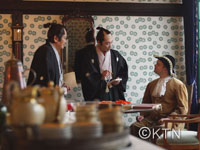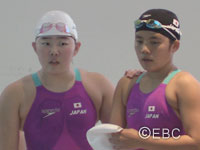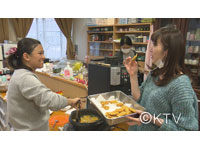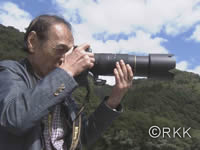Documentary
![]()
The Unsung Experts of Japan | Japan in Focus | Discover Asia | Japan’s Unsung Masters - Live! | NINJA | BOSAI: Be Prepared |
“DEJIMA” Where the World Met Japan
DC281871![]()
長崎DEJIMA~現在・過去・未来~ [KTN]
![]()
![]()

|Length : 47 |Year : 2018 |
Take a trip to Nagasaki’s Dejima, an island that connected Japan to the world.
During the two centuries after its creation in 1636, this island was the only place where interactions between Japan and the West took place, earning its place in Japanese history as a “foreign country within Japan.” Dejima was inhabited for limited periods by people from The Netherlands, including the Trading Post Chief (the “Kapitan”), scholars, and their supporting crew. Japanese officials and their interpreter “Tsuji” would also come and go. The island was connected to land by the short “Omotemonbashi” bridge, which become the funnel from which all things western would enter Japan. In this program, we celebrate the revival of the Omotemonbashi bridge after 130 years by taking a look at the history, people, things, and culture of Dejima with artifacts and reenactments, paying particular heed to one Tsuji named Tadao Shizuki and the Japanese words he coined for “present, past, and future.”
“Two Para Swimming Rivals:Same Age, Same Name,Same Dream”
DC281870![]()
2人の“ほのか” [EBC]
![]()
![]()

|Length : 47 |Year : 2018 |
Young swimmers, Honoka Okabe and Honoka Nakamichi are born in 2000 and raised in Ehime, Japan. Coincidentally, their given name and their age are the same.
Okabe has congenital disorder of her right arm from the elbows up. Nakamichi has no right leg as a birth defect. They began swimming in their childhood, but went to different swimming school. They met in their sixth year of elementary school, which was a wonderful encounter for them.
It is important for them to practice properly for the type of disability. They also have trained with disabled swimmers in nationwide.
Their next goal is to the take part in the competitive swimming 2020 Tokyo Paralympics. They are keep training towards the goal, encouraging each other.
Medical Transplantation Joins Japan to Asia ~The Challenge of the Doctor named”God’s Hands”~
DC281869![]()
「メッセージ」 岡山発アジアへ~肺移植・大藤医師の挑戦~ [RSK]
![]()
![]()

|Length : 48 |Year : 2018 |
A lung transplant is the most difficult in organ transplants. Takahiro Oto, a 50 year-old doctor in Okayama University Hospital, has succeeded lung transplanting surgeries in 100 percent. Since organ donation from people declared brain dead is quite few in Japan, patients who want organ transplant will pass away before the surgery. Dr. Oto has saved many patients who used to have no choice but giving up the surgery, with his rich experience and by using advanced medical technology. For example, he successfully completed a transplant inverting the lungs to right and left, “hybrid lung transplant” that made of each lung from a brain-dead donor and from a living person, a transplant of one lung combined the lobes of the right and the left lung, and so on. “I want to save more lives,” said Dr. Oto about the reason why he tries such difficult surgeries. Now his hope is going beyond national borders—he received a request from Vietnam. It is a surgery of a 6-year-old boy who is suffering from a severe lung disease, and the transplant is the only way to survive. Vietnam does not have enough facilities for the lung transplant, however, Dr. Oto struggles to save him. We closely covered his challenge for the future of a lung transplant in Asia.
The Struggles and the Dreams of Foreign Care Workers in Japan
DC281868![]()
さくらの国に来て、、、 [KTV]
![]()
![]()

|Length : 55 |Year : 2018 |
It is said that in Japan, with an aging society, there will be a shortage of 340,000 care workers by 2025. For care centers, it is essential to welcome help from abroad.
In our program we follow two Indonesians who have come to Japan under an EPA program signed between Japan and Indonesia. They have been working at a welfare center, Hachikikai, since December 2017, at the same time studying to become certified care workers.
Under the EPA program, if they pass the certification exam within four years, they can stay and work in Japan. At Hachikikai, the staff fully supports them and helps them study even during work hours. The reason is that they want the two to continue working at their center. The staff at Hachikikai are kind and treat them as family, however they still have their own difficulties and worries.
Our program shows a very real picture of the struggles, hopes and dreams of these and other Indonesian people working hard in a land far from home.
A Record of Life in Minamata
DC281765![]()
命の記録~写真家・桑原史成の水俣~ [RKK]
![]()
![]()

|Length : 24 |Year : 2017 |
Shisei Kuwabara, a photographer in Tokyo, organized a group photoshoot in the city of Minamata in 2016. The subjects of this shoot are Minamata disease patients and their families, around 40 in all. Mr. Kuwabara has photographed them continuously for the past fifty years and beyond.
Minamata disease is a central nervous system disorder caused by methylmercury poisoning via seafood contaminated by factory wastewater. Its victims were families of fishermen: the adults, their children, even their unborn children. In 2016, some of these fetal Minamata disease patients turned 60 alongside the 60th anniversary of the official recognition of Minamata disease. Some of the patients and families Mr. Kuwabara knew had passed away, or were bedridden.
Mr. Kuwabara wished to express 60 years of the Minamata incident in a photograph. To this end, he prepared past photographs of the patients and their families. Held by the group photo participants, each image harkens back to the effects of the incident and the emotions of its victims.
For the 80-year-old Mr. Kuwabara, this may be his final “shutter chance” in Minamata. How will he frame his subjects with their complex, often bitter circumstances? The present reality of Minamata comes to light through Mr. Kuwabara’s interactions with surviving victims and in his photograph.















